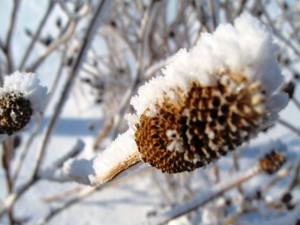In a place like Nebraska the winter landscape is best enjoyed from the coziness of the indoors. The winter view can often be forgotten about when planning your garden design. I like to think about different plants that I notice in a winter landscape. What looks pretty or interesting poking out from a snow drift, or carefully frosted with ice and snow by Mother Nature herself? I have a handful of plants which I particularly think add to the view of the outdoors from the inside. Let’s think beyond flowers and consider what other attributes plants have that add to their interest like texture, form or color of: bark, seed heads, berries, and foliage. I’d like to move beyond the obvious winter beauty queen candidate which is the evergreens and focus on deciduous trees, shrubs and perennials.
In the fall I like to leave perennials such as sedum, rudbeckias and coneflowers standing (as long as they are not broken or flopping) because of their seed heads that pop up like little soldiers through a winters snow. Cut them back in spring and they will start their next season fresh. There are some lovely evergreen perennials which you might not think about such as hellebores, armeria and bergenia. I love hellebores because of its unique foliage and beautiful early spring blooms. Not to mention this plant is deer and rodent proof and is a shade lover. It’s hard to find a perennial which has so much to offer. Armeria is a favorite because of its tufted form of thread like foliage which is available in a variegated color and their dried flower heads are an added bonus. Bergenias provide a thick fleshy evergreen leaf whose glossy shine can catch the eye when the winter sun reflects off of a fresh coating of snow which can’t be missed. I’m going to go ahead and safely add all ornamental grasses to this handful of perennials because of the colors, texture and motion that they all acquire. If I had to pick three I would probably choose the following: bluegrass (because of its color), switchgrass (because of its seedhead) and feather reedgrasss (because of its tough as nail attitude and resistance to flopping).
If I had to pick three shrubs to be in my personal landscape for winter gazing it would be hydrangea, winterberry and witch hazel. I always leave flower heads on my hydrangea because I love the way they look dried and when they have snow on them they look even prettier. Winterberry is an unbelievably beautifully plant which is quite inconspicuous during the warm season but once they bear fruit and drop their leaves in the fall, winterberry cannot be missed because the masses of bright red berries whirled around the smooth gray branches is absolutely show stopping. Witch hazel is another plant which seems to magically bloom during those cold winter days when it seems as though there is no life in the outdoors. Their fingery looking flowers in colors of yellow to red burst from the naked stems of the shrub and will catch anyone who sets their eyes upon it.
I recently planted a paperbark maple and I cannot wait until it matures so I can gaze upon its awesome coppery curly bark. It is a super cool tree which I highly recommend for an interesting winter garden. Another tree which I want but haven’t had a chance to plant at home yet is a lacebark pine. You might think this would be on the planting wish list because of its evergreen attributes. This is not the case at all, in fact these have extremely interesting bark which like the paperbark maple becomes more impressive as it ages. The bark looks like a patchwork of camouflage in green, blue and gray hues. I won’t forget the first time I saw a lacebark pine…wow. I have a lot of clients who are leery about installing crabapples in their personal landscape. There are so many varieties which provide spring flowers, summer fruit and color and fall color. What many people don’t know is that crabapples are now bred to have persistent fruit which means that the fruit stays attached to the plant. In other words, these new crabapples won’t make a mess. An added plus is that these fruit will remain on your trees throughout the winter months and are so showy during a time when so many plants have little to offer in terms of attractiveness.
By Alyssa Eyman









